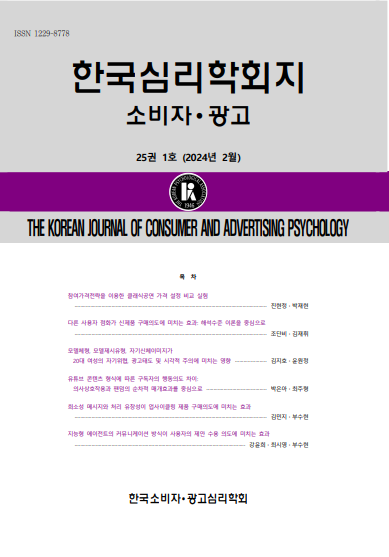open access
메뉴.png)
open access
메뉴 ISSN : 1229-8778
ISSN : 1229-8778
동일한 사람이 내리는 결정이라도 결정의 수혜자에 따라 결정의 결과가 다르게 나타날 수 있다. 본 연구에서는 중고 스마트폰 구매 상황에서 금전적인 혜택을 더 누릴 수 있지만 다소 위험을 감수해야 하는 대안과 금전적인 혜택의 정도는 상대적으로 작지만 위험 감수 정도를 최소화할 수 있는 대안 사이에서 자기 또는 타인을 위해 결정을 하도록 하여 결정의 수혜자가 결정의 결과에 미치는 영향을 살펴보고자 하였다. 결정의 수혜자가 누구인지 뿐 아니라 결정자가 본래 가지고 있는 성향도 결정의 결과에 영향을 줄 것이다. 본 연구는 결정의 수혜자가 결정에 미치는 영향을 보다 입체적으로 살펴보기 위해서 개인의 자기해석과 해석수준의 영향력도 함께 살펴보고자 하였다. 이를 위해 2(대상: 자기/ 타인) X 2(해석수준: 상위/하위) X 2(자기해석: 독립적/상호의존적)의 삼원 완전무선 요인설계로 실험을 진행하였고, 결정 대상과 해석수준 그리고 자기해석수준 사이에 삼원 상호작용 효과가 관찰되었다. 독립적 자기해석으로 점화된 조건의 상위해석자는 대상에 따라 위험감수 정도에 따른 차이가 크지 않았지만, 하위해석자는 타인을 위한 결정에서 위험을 감수하려고 하는 의도가 증가하였다. 상호의존적 자기해석으로 점화된 조건의 하위해석자는 결정 대상이 누구인지와 무관하게 위험감수 구매 의도가 모두 낮았지만, 상위해석자는 타인을 위한 결정일 때에는 위험감수 의도가 다소 증가하였다. 자기 또는 다른 사람을 위해서 현명한 결정을 내리는 것은 삶의 질을 향상시키는 데 중요한 역할을 할 것이다. 본 연구는 소비자가 자기 또는 다른 사람을 위해서 결정을 해야 하는 상황에서 보다 바람직한 결정을 내리는 데 도움이 될 수 있도록 결정 과정에 대한 이해의 깊이를 더하고자 하였다.
It is inevitable to make small and big decisions unceasingly in our daily lives. They include decisions not for oneself but for others. In order to investigate how the decisions are made in risk-taking situations, this study is to examine how the self-construal level and construal level of the participant could impact in risk-taking situations. Each participant was randomly assigned to one of eight conditions in the experimental of 2(decision object: self/other) X 2(construal level: high/low) X 2(self-construal: independent/interdependent) 3-way completely randomized factorial design. The result also shows an effect of correlation among decision object, construal-level, and self-construal level. Participants who have high-construal and independent self-construal take high risk choices for both self and others, whereas participants who have low-construal and independent self-construal take low risk options for self and high risk options for others. On the other hand, in interdependent self-construal condition, they take low risk option for self regardless of their construal levels, whereas participants who have high-construal take high risk options for others and participants who have low-construal take low risk option others. The research results implicate that people have a tendency to take higher risks for the choices for others than for themselves but the tendency diminishes when they feel responsibilities or similarities with the others. Through the measurement of construal levels and self-construal levels, it has been identified that individuals' variable also has an influence on the results. The effect of types of purchase decision beneficiaries and deciders' individual characteristics on making risk-taking decisions, which has been investigated in this study, is considered to provide implications to risk-taking decisions in various area.
조숙자, 방희정, 조혜자, 김현정 (2006). 개인특성 및 자아해석 양식의 단기 활성화에 따른 도움행동 양상에 관한 연구. 한국심리학회지: 여성, 11(3), 267-286.
Beisswanger, A. H., Stone, E. R., Hupp, J. M., & Allgaier, L. (2003). Risk taking in relationships: Differences in deciding for oneself versus for a friend. Basic and Applied Social Psychology, 25(2), 121-135.
Danziger, S., Montal, R., & Barkan, R. (2012). Idealistic advice and pragmatic choice: A psychological distance account. Journal of Personality and Social Psychology, 102(6), 1105-1117.
Fischhoff, B. (1992). Giving advice: Decision theory perspectives on sexual assault. American Psychologist, 47, 577-88.
Hamilton, R. W., & Biehal, G. (2005). Achieving Your Goals or Protecting Their future? The Effects of Self- View on Goals and Choices. Journal of Consumer Research, 32, 277-283.
Kray, L. (2000). Contingent weighting in self-other decision making. Organizational Behavior and Human Decision Processes, 83(1), 82-106.
Kray, L., & Gonzalez, R. (1999). Differential weighting in choice versus advice : I’ll do this, you do that. Journal of Behavioral Decision Making, 12, 207-217.
Laran, J. (2010). Goal management in sequential choices: Consumer choices for others are more indulgent than personal choices. Journal of Consumer Research, 37(2), 304-314.
Lermer, E., Streicher, B., Sachs, R., Raue, M., & Frey, D. (2014). The effect of construal level on risk-taking. European Journal of Social Psychology, Eur. J. Soc. Psychol.
Lerner, J., & Tetlock, P. (1999). Accounting for the effects of accountability. Psychological Bulletin, 125, 255-275.
Loewenstein, G., Weber, E. U., Hsee, C. K., & Welch, N. (2001). Risk as feelings. Psych. Bull, 127, 267-286.
Mandel, N. (2003). Shifting selves and decision making: The effects of self-construal priming on consumer risk-taking. Journal of Consumer Research, 30(1), 30-40.
Pollmann, M. H., Potters, J., & Trautmannb, S. T. (2014). Risk taking by agents: The role of ex-ante and ex-post accountability. Economics Letters, 123, 387-390.
Polman, E. (2010). Information distortion in self-other decision making. Journal of Experimental Social Psychology, 46, 432-435.
Polman, E. (2012). Self-other decision making and loss aversion. Organizational Behavior and Human Decision Processes, 119, 141-150.
Polman, E. (2012). Effects of self–ther decision making on regulatory focus and choice overload. Journal of Personality and Social Psychology. 102(5), 980-993.
Polman, E., & Emich, K. J. (2011). Decisions for others are more creative than decisions for the self. Personality and Social Psychology Bulletin, 37, 492-501.
Vallacher, R. R., & Wegner, D. M. (1989). Levels of personal agency: Individual variation in action identification. Journal of Personality and Social Psychology, 57(4), 660-671.
Van Boven, L., & G. Loewenstein, G. (2003). Social projection of transient drive states. Psych. Bull, 29(9), 1159-1168.
Van Boven, L., & Loewenstein, G. (2005). Cross-situational projection. The Self in Social Judgment, Psychology Press, 43-64.
Van Boven, L., Loewenstein, G., & Dunning, D. (2003). Mispredicting the endowment effect: Underestimation of owners’ selling prices by buyer’s agents. Journal of Economic Behavior and Organization, 51(3), 351-65.
